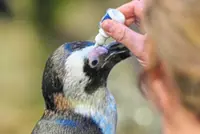Two Adelie penguins stand on a block of melting ice atop a rocky shoreline at Cape Denison, Commonwealth Bay, East Antarctica. Photo: Reuters/Pauline Askin
The evolution of penguins from their flying seabird ancestors into the flightless denizens of marine environments from frigid Antarctica to the tropical Galapagos Islands is among the wonders of the animal kingdom.
Researchers on Tuesday (July 19) offered the most thorough examination to date of the history of penguins dating back to their origins more than 60 million years ago, including identifying a suite of genes crucial in adaptations related to underwater vision, long dives, body temperature regulation, diet and body size.





